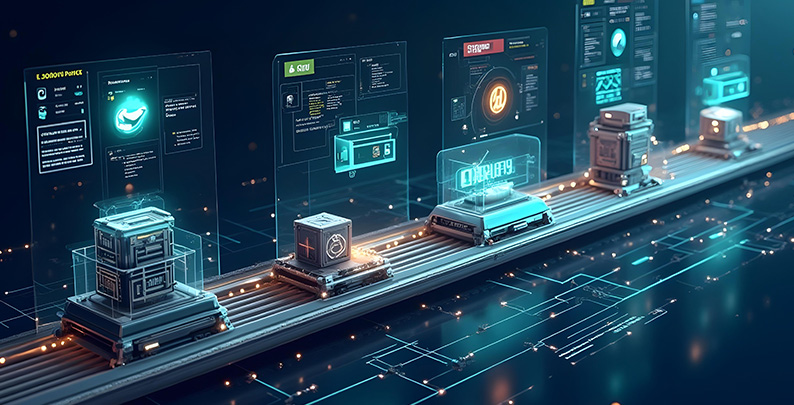Table of Contents
Switching between Unity, Unreal, Git, and Perforce often feels like juggling four different workflows, and dropping any one of them can cost time, money, and sanity. At Juego Studios, we help you bring it all together into a single, streamlined pipeline. Our tested methods help studios work more efficiently while maintaining high quality across various engine workflows. Ready to transform your development pipeline? Read on to discover expert strategies.
Today’s game development teams need to use many different engines, version control systems, and collaboration tools at the same time. Studios often use Unity for mobile games while using Unreal Engine for console games, creating complicated workflows that must work with Git repositories and Perforce asset management systems.
 The Chaos of Disconnected Game Tools
The Chaos of Disconnected Game Tools
The primary concern is ensuring pipeline alignment without issues. When tools don’t connect properly, teams face constant problems switching between systems, handling different file types, and coordinating work across teams in different locations. This separation causes delays, mistakes, and frustrated developers who spend more time dealing with tools than making games.
Good pipeline alignment needs careful planning and deep knowledge of what each tool does well and where it struggles. Teams that master this connection get big advantages through faster work cycles, fewer mistakes, and better teamwork across all areas.
 Split Ecosystem: Unity vs Unreal
Split Ecosystem: Unity vs Unreal
Game studios today rarely use just one engine or set of tools. Teams use Unity for quick prototyping and mobile development while using Unreal Engine’s advanced graphics features for big console games. This multi-engine approach gives flexibility but makes it harder to keep development practices consistent.
The challenge goes beyond game engines to include the entire development system. Artists work in Maya or Blender, designers use special level editors, programmers need development environments, and project managers need to see what’s happening across all areas. Each tool creates files, information, and connections that must be tracked, versioned, and synchronized.
Common Tool Integration Challenges:
| Challenge Category | Specific Issues | Impact on Development |
| File Format Compatibility | Different asset formats between engines | Asset recreation, workflow duplication |
| Version Control Conflicts | Mixed text/binary files, merge conflicts | Lost work, development delays |
| Build Process Variation | Different compilation requirements | Inconsistent deployment, testing gaps |
| Team Communication | Scattered tool notifications, status updates | Coordination failures, missed deadlines |
| Resource Management | Competing tool resource requirements | Performance issues, development bottlenecks |
Common Tool Integration Challenges
Game projects include huge binary files like 3D models, textures, audio files, and compiled shaders that create special challenges for version control. Unlike regular software development, these assets cannot be combined meaningfully when conflicts happen, requiring special handling and coordination strategies.
Modern game files can be gigabytes in size, so you need systems that can:
Git is great for managing code because it lets developers work offline and create separate branches for trying new features. This helps during the creative process when you’re experimenting with different ideas.
But Git has problems with large game files. Image files, 3D models, and audio can’t be merged when conflicts happen, and Git doesn’t compress these files well. Git LFS (Large File Storage) helps by storing big files separately while keeping links in the main repository.
Perforce is the industry standard for game development because it’s designed to handle millions of files, including very large ones. It works differently than Git – everything is stored in one central place, which has advantages for game development:
Many modern game teams use both Git and Perforce together. They use Git for code (because it’s better for programming) and Perforce for art and design files (because it handles large files better).
This approach requires careful planning to make sure code and art files stay connected properly across both systems. Teams need clear rules for managing dependencies between the two systems.
Unity is designed to be flexible and easy to use, which is why indie developers and studios making mobile games love it. Unity takes your art files and converts them into formats that work well when your game is running.
Unity can save many file types in text format, which makes version control much easier. You can see what changed, merge files, and resolve conflicts for scenes, prefabs, and other Unity files.
Unity’s Package Manager adds complexity because packages can come from different places. Teams need clear rules for managing packages to make sure builds work consistently.
Unreal Engine works very differently from Unity. It focuses more on visual scripting (called Blueprints) and has more advanced graphics features. The build system is more complex and needs to be integrated carefully with your development pipeline.
Most Unreal files are stored in binary format (.uasset files) that can’t be merged when conflicts happen. This makes file locking very important – multiple developers can’t work on the same file at the same time without risking data loss.
Unreal’s support for huge game worlds adds more complexity, as level files might be split across multiple files that need to be updated together.
 Unified CI/CD for Unity and Unreal
Unified CI/CD for Unity and Unreal
Continuous Integration and Deployment (CI/CD) means automatically building, testing, and releasing your games. This helps teams release games faster and with fewer bugs.
When you automate testing and deployment, you reduce human mistakes, which means fewer bugs and more stable releases. You can set up systems to run comprehensive tests automatically, making sure your code stays high quality.
GameCI is a free, community-driven solution that makes CI/CD easy for game developers of all skill levels. It provides simple tools that don’t require deep technical knowledge but still give you professional features.
GameCI is built on proven technologies and follows industry best practices. It works with multiple systems and cloud providers, so you can use the technologies you prefer.
Setting up automation across Unity and Unreal Engine requires understanding how each platform works. Unity projects work well with GameCI’s Unity-specific tools that handle licensing, build targets, and testing automatically.
For teams using both Unity and Unreal Engine, having consistent systems is crucial for keeping developers productive and reducing the mental overhead of switching between different tools.
| Component | Unity Implementation | Unreal Implementation | Shared Benefits |
| Build Triggers | Unity Cloud Build API | Unreal Automation Tool | Consistent trigger mechanisms |
| Testing Framework | Unity Test Framework | Unreal’s Gauntlet | Automated quality assurance |
| Asset Processing | Unity Asset Pipeline | Unreal Build Tool | Parallel processing |
| Platform Builds | Unity Build Settings | Unreal Target Rules | Multi-platform support |
| Deployment | Unity Cloud Deploy | Custom Unreal Scripts | Automated distribution |
Multi-Engine Pipeline Architecture
Key Implementation Steps:
Docker containers package all the tools and dependencies your project needs, making sure builds work the same way on every computer. Game development often requires specific versions of engines, SDKs, and build tools that can conflict when installed directly.
Docker containers solve this by packaging everything together. GameCI uses Docker extensively to provide pre-configured containers for popular game engines, eliminating the complex setup traditionally required.
Modern game development tools provide APIs (programming interfaces) that let you create custom connections and automated workflows. Unity’s Cloud Build API lets you manage build configurations programmatically, while Perforce’s REST API enables custom integrations with project management systems.
Connecting these APIs lets you link game development pipelines with business systems like project management tools, analytics platforms, and customer support systems.
| Tool/Platform | API Capabilities | Integration Benefits |
| Unity Cloud Build | Build configuration, trigger management, status monitoring | Automated build scheduling, custom deployment triggers |
| Perforce REST API | Repository management, user administration, change tracking | Custom workflow automation, integration with project tools |
| Unreal Automation Tool | Build scripting, testing automation, deployment | Streamlined build processes, automated quality assurance |
| Git Webhooks | Event notifications, automated triggers | Real-time pipeline updates, cross-system synchronization |
| JIRA/Azure DevOps | Issue tracking, project management, reporting | Unified project visibility, automated status updates |
Essential API Integration Points
Establishing Consistent Workflows
Making consistent workflows across different tools requires paying attention to common patterns that work everywhere. This includes naming conventions for files, code organization patterns, and branch management strategies that work with both Git and Perforce.
Documentation and training are crucial for making sure everyone understands and follows the established pipeline conventions. Living documentation that evolves with your pipeline helps new team members become productive quickly.
Pipeline standardization checklist:
Juego Studios has lots of experience connecting complex game development pipelines across Unity, Unreal Engine, Git, and Perforce systems. Our team understands the unique challenges of multi-engine development and has successfully set up integrated workflows for studios of all sizes. We provide comprehensive solutions that include strategic planning, technical implementation, team training, and ongoing support to ensure your pipeline operates efficiently. Our proven methods reduce development problems, speed up work cycles, and improve collaboration across all team members. With deep knowledge of industry best practices and new technologies, we help studios future-proof their development processes while keeping flexibility to adapt to changing project needs.
Successfully connecting pipelines across Unity, Unreal Engine, Git, and Perforce requires strategic planning, technical knowledge, and commitment to best practices. Teams that invest in proper integration gain significant advantages through better efficiency, fewer errors, and improved collaboration.
Tools like GameCI make professional development practices accessible to studios of any size. As the industry continues moving toward multi-engine development and hybrid version control strategies, teams with strong, well-integrated pipelines will be better positioned to adapt to future changes while staying competitive.
The main problems include handling different file types, managing separate build processes, coordinating version control across engines, and keeping team workflows consistent. Each engine works differently for compilation, asset processing, and deployment, which makes integration challenging.
It depends on your team size, project complexity, and what types of files you work with. Git works well for code and smaller projects, especially with Git LFS for assets. Perforce is better at handling large binary files and complex asset management. Many teams use both – Git for code and Perforce for assets.
GameCI provides ready-made Docker containers and automation tools built specifically for game engines. It offers simple APIs that don’t require deep technical knowledge while still providing professional-grade features, making advanced CI/CD practices available to teams of any size.
Docker containers make sure builds work the same way across different computers by packaging all the necessary tools and dependencies together. They prevent version conflicts, make setup easier, ensure consistent builds no matter what computer you use, and support building for multiple platforms.
Large binary assets need special handling through systems like Perforce Helix Core or Git LFS. Use file locking for assets that can’t be merged, use dedicated storage solutions for huge files, establish clear asset organization rules, and ensure fast access through proper infrastructure planning.
API integration connects different tools and systems, enabling automated workflows, real-time status updates, and smooth data exchange. APIs let teams create custom automations, integrate with business systems, trigger builds automatically, and maintain visibility across the entire development process.